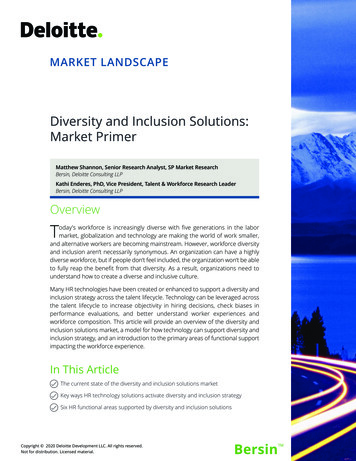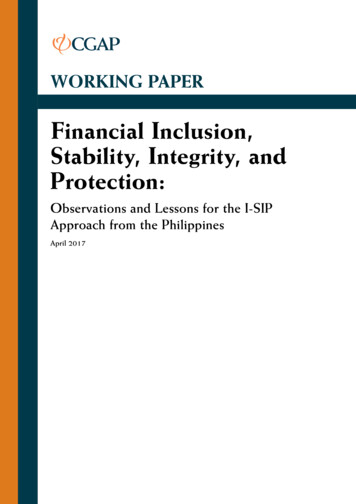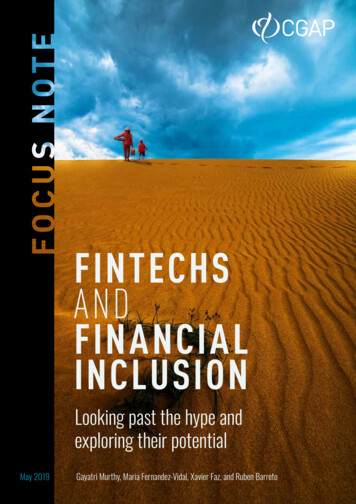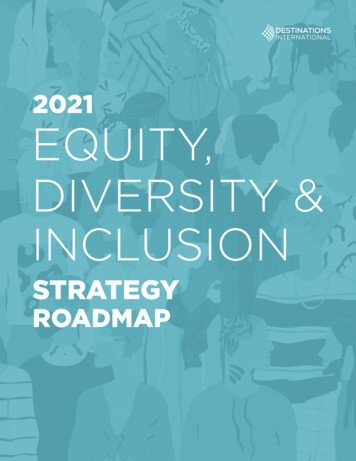
Transcription
In collaboration withBoston Consulting GroupAccelerating DigitalInclusion in the New NormalPL AY B O O KJ U LY 2 0 2 0
Cover: Getty Images/Dobrila VignjevicInside: Getty Images/Subman; Reuters/Amit Dave;Reuters/Danish Siddiqui; Unsplash/Dan Burton;Reuters/Alessandro Bianchi; Reuters/Jason RedmondContents3Executive summary41 Role of connectivity in the time of COVID-1952 Critical gaps in the digital divide73 A growing digital divide in the ‘new normal’84 The future of digital inclusion84.1 Growth134.2 Financing184.3 Technology21Conclusion22Acknowledgements23Endnotes 2020 World Economic Forum. All rightsreserved. No part of this publication maybe reproduced or transmitted in any formor by any means, including photocopyingand recording, or by any informationstorage and retrieval system.Accelerating Digital Inclusion in the New Normal2
Executive summaryThe COVID-19 crisis has thrown into sharp focusthe importance of digital connectivity in daily life. Asmany countries underwent lockdown periods, digitalinfrastructure was critical to mitigate the impact ofstay-at-home restrictions. Connectivity players havecontributed by taking short-term actions to ensurecontinued access during the crisis. More importantly,their long-term investment in infrastructure overthe past 20 years has driven a step change in thelevel of fixed and mobile coverage and technology.This has enabled the continuation of key activitiesdigitally, such as remote working, healthcare andeducation, and underpinned the growth of sectorssuch as e-commerce while supporting adjacentindustry players at a critical time.At the same time, the crisis has also exposed evenmore clearly the gaps that still exist in digital access.When essential services such as health, educationor simply being able to continue one’s professionalactivity depend on connectivity, the inequalitiesbecame exacerbated. There remains a divide inaccess to high-speed fixed and mobile connectivity.Even among fixed broadband subscribers, manydo not get sufficient speeds for effective remotework, telemedicine or study, including in developedcountries. Beyond coverage, there is a bigger dividein adoption where those with coverage may notuse the internet due to lack of affordability, digitalskills or relevant content in the local language.Furthermore, these issues extend to businessesthat faced similar challenges during the crisis. InGrowthparticular, small and medium-sized enterprises(SMEs) lag behind large corporations, renderingthem more vulnerable to closures and job losses inan environment where digital is increasingly key.The post-COVID-19 “new normal” will likely see anincrease in speeds, devices and budgets requiredby households and businesses, exacerbatingexisting divides. As such, connectivity mustbecome the top priority and stakeholders must aimfor United Nations targets: by 2025, broadbandinternet1 user penetration should reach 75%worldwide, and by 2025, broadband shouldcost no more than 2% of earnings. It will also beimportant to implement the UN Secretary-General’sRoadmap for Digital Cooperation. To achievethis, stakeholders should aim to drive adoption ofhigh-speed internet beyond coverage targets andtake a “tech agnostic” approach, where traditionalbusiness cases are insufficient – this incorporatesterrestrial and non-terrestrial infrastructureoptions for providing access to high-quality fixedbroadband, wireless and satellite networks.At this watershed moment, telcos and industryverticals, multinational corporations, governmentaland non-governmental organizations must mobilizeto develop strategies to accelerate digital inclusion.This playbook builds on past efforts by the WorldEconomic Forum and other groups (e.g. GSMA,Broadband Commission) and highlights further keyrecommendations across three pillars:FinancingHow can the public and private sectorsstimulate growth in the industry to acceleratedigital development in unserved andunderserved regions?How can the public and private sectors bestfinance the infrastructure and digitizationrequired to enable high-speed internet inunserved and underserved regions?–Accelerate current efforts, particularly onincreasing adoption through improvedaffordability and digital skills–Accelerate relevant partnerships andregulatory actions identified––Set up horizontal national digital strategiesand disburse unused funds via efficientmechanismsInvolve more non-telco actors in infra-sharingdiscussions–Creatively and assertively seek access to outsidefunding available for digitization and connectivity;explore ways to earmark recent recovery funding–Collaborate with government to addressbureaucratic hurdles of to speed up roll-out–Collaborate across sectors and governmentsto facilitate the digitization of SMEs throughend-to-end “digital SME in a box” solutions,as a key revenue growth driverTechnologyWhat combination of existing and emergingtechnologies can efficiently and sustainablydeliver affordable connectivity?–Continue optimizing for the right mix oftechnologies across fixed, wireless and newnon-terrestrial technologies across contexts–Accelerate the digitization of existingoperations through smart planning,automation, new architectures and ways ofworking, to improve the cost base and viabilityof investments in underserved areasAccelerating Digital Inclusion in the New Normal3
1Role of connectivity inthe time of COVID-19The COVID-19 pandemic has highlighted a newfound senseof urgency to the digital inclusion agenda. While the crisis hasenabled hundreds of millions to work, learn and connect digitally,it is easy to see how it has also exacerbated the situation forfar too many people in vulnerable situations around the world.Now, more than ever, connectivity should be at the core of allnational and international priorities – from healthcare, education,government services and beyond. This new normal presentsan unprecedented opportunity for cross-sector collaborationto bridge the digital divide and enable unforeseen growthopportunities for the economy and society.Mauricio Ramos, Chief Executive Officer, Millicom, USA; Chair, DigitalCommunications Industry Community, World Economic ForumThe ongoing COVID-19 crisis has generated afundamental change in the context connectivityand tech players operate in, as societies areincreasingly recognizing the critical importanceof digital infrastructure and services. By end ofApril 2020, 70% of countries globally were facedwith some level of stay-at-home requirements, amajority of which were strict lockdowns. Duringthis period, internet use grew by as much as70%, the use of remote desktop by 40% andthe use of virtual collaboration tools by morethan 600%.2 Connectivity and tech players haveplayed a key role in supporting this crisis withshort-term response actions, as detailed in theDigital Development Joint Action Plan and Call forAction published in April 2020 by the World Bank,International Telecommunication Union (ITU), GSMAand World Economic Forum.However, beyond the instrumental role held bythe industry in the short term, the most importantenabler allowing the world to operate duringthese lockdowns has been the substantialinfrastructure roll-out and investments made by theindustry since the internet boom. Operators andinfrastructure providers have invested trillions ofdollars over the past 20 years to create the digitalinfrastructure coverage and capacity required tosustain lifestyles during COVID-19. From almostnothing two decades ago, today close to 45%of global households have a fixed broadbandsubscription, of which close to half enjoy fibreconnections and speeds. In the same timeframe,mobile coverage has risen from 12% to 97% of theworld’s population, with more than 85% enjoying4G technology.3This solid digital infrastructure has enabled thecontinuation of key activities, allowing an estimated10% of the global labour force to work remotely,supporting close to 300 million jobs. This translatesto an annual impact of 8 trillion, or twice the sizeof the Germany’s economy. A similar number ofschool-aged kids and university/higher educationstudents – 100 million and 200 million,respectively, have also been able to maintainaccess to education remotely. While this represents15-30% of the global student population, it isweighted towards developed economies.4Connectivity also had a significant impact onmanaging health-related issues during the crisis;technology was used for pandemic planning,surveillance, testing, contact tracing, quarantineand remote healthcare. Telemedicine consultationsgrew more in one month than in 10 years,5 whichplayed a key role in keeping lines down at hospitalsand maintaining patients in good health. Whilesome sectors have been badly hit (e.g. travel andhospitality), others have been able to grow duringthe lockdowns, directly enabled by connectivity,such as e-commerce, food delivery and onlinegroceries, with positive spillover effects to adjacentindustry players, all of which would have beenimpossible 20 years ago.Accelerating Digital Inclusion in the New Normal4
2Critical gaps in thedigital divideDespite support from the industry, the currentcrisis has also highlighted gaps in access andexacerbated the existing digital divide, both indeveloping and developed markets:–Fixed network coverage, penetration andspeeds are still lacking in many middle- andlow-income countries. Indeed, less than 10%of households in low-income countries are fixedbroadband subscribers, compared to 70%and close to 90% in middle- and high-incomecountries, respectively. More importantly,over half of these low-income broadbandsubscribers have access to speeds 10Mbps.Even in higher-income economies, such asthe US or European markets, 10% of thebroadband subscribers still get speeds below10Mbps and close to 30% below 30Mbps.Speeds above these levels would enable amore enhanced usage of connectivity, bettersimultaneous virtual communication (VC) forwork and school, and an overall improved userexperience. These speeds were impacted due–Beyond availability of infrastructure, a wideaffordability gap continues to exist, drivinga usage gap between penetration andcoverage. In low-income countries, a monthlybroadband subscription costs 12% of grossnational income (GNI), far higher than the UNtarget of less than 2% by 2025. Similarly, theto the recent crisis, as a result of increasednetwork traffic, hitting lows of 5Mbps in upstateNew York for example, preventing somecommunities, mostly rural, from accessing theinternet at all.6–Mobile connectivity coverage and capacityimprovements are needed within the highspeed internet discussion, especially as 4Gcan bring speeds comparable to broadband inselected markets. Despite a 40% increase inthe number of people connected to the internet( 1 billion) in the past five years, over 30% oflower-income country populations are not yetcovered by 4G and those who are benefit fromrelatively poorer speeds than their higherincome counterparts. That said, an estimatedadditional 25% of the global population, beyondthose enjoying high-speed fixed connections,can access internet speeds above 30Mbpsthanks to 4G connectivity today. A combinationof access technologies, including satellites, willbe explored under technology.cost of a basic smartphone ( 150) representsmore than 1.2 months’ wages in these lowincome countries, and at least 3-4 times thatfor laptops, which is becoming one of thelargest barriers to internet adoption, evenwhere coverage exists. Indeed, smartphoneownership drops to 30-60% in low-incomeAccelerating Digital Inclusion in the New Normal5
countries and only 21% for personal computer(PC) ownership. The ownership of PCs alsoremains too low in middle- and higher-incomeeconomies at 57% and 85%, respectively,driving significant limitations especially interms of remote education during the recentlockdowns.7–Digital literacy is an additional barrier toadoption by certain communities, both indeveloped and developing markets. In lowerincome economies, only 32% of the populationhas basic digital skills (i.e. defined as the abilityto copy or move a file or send e mails). Evenin higher-income economies, this numberplateaus around 62% and drops rapidly to 44%if standard skills (i.e. defined as the ability touse basic formula in a spreadsheet or createelectronic presentations) are considered,which also creates high barriers to adoptingthe required digital services to enable aremote lifestyle.8 Digital literacy is also closelyintertwined with the availability of relevant usecases, localized content, products and servicesattractive for user consumption, or lack thereofin some markets.These gaps do not stop at individuals andhouseholds. Businesses, specifically SMEs, havebeen lagging behind and are particularly exposedin this crisis, despite the critical role they play inglobal economies. SMEs represent more than90% of businesses worldwide and half of globalemployment, and even more in emerging marketswhere they drive more than half of GDP.9 However,they lag far behind larger companies in terms ofICT adoption and maturity. Less than half havefixed broadband connectivity and overall less thana quarter are digitized (offering some service online)compared to almost 100% for larger companies.10Therefore, at most, 10-20% of SME employeeshave been able to work remotely during lockdownsversus over 50% for large companies, even in highincome markets such as Japan.11This obviously exacerbated the already significantimpact of the COVID crisis on SMEs. They havebeen particularly vulnerable and at risk of sufferingmore job losses and closures compared tolarger companies; for example, 2.5 times moreredundancies/employee vs larger companies inFrance.12 This gap is expected to widen as earlyevidence shows resumption rate post-lockdownsis slower for SMEs compared to larger companies,and a vast majority of support actions announcedglobally disproportionately focus on largecompanies. They must not be excluded from thedigital inclusion discussion.Despite billions of dollars of investments, massiveconnectivity progress globally and strong continuedefforts across the industry, these gaps have beenexacerbated in the recent crisis and are likely topersist and even worsen once the world reachesa “new normal” with pervasive digitization acrossall aspects of life. Individuals and businesseswill become accustomed, and will be expected,to conduct key activities online, thus shiftingconsumer habits to more virtual lifestyles andincreasing reliance on technology and connectivity.Accelerating Digital Inclusion in the New Normal6
3Reasonablespeeds needed inthe new normal:high-income 100Mbpsmiddle-income 50MbpsA growing digital dividein the ‘new normal’Post-COVID-19, the “new normal” will likely seean acceleration of digital activities across variousaspects of daily life. While not all jobs can bedone remotely, and some level of in-person workis likely to resume, there is likely to be increasinguse of advanced virtual conferencing in day-today meetings, workshops, upskilling trainings,or even team building for colleagues in differentlocations. Similarly, schools are likely to continueleveraging some level of online education inthe future, from sharing pre-recorded lectures,launching homework collaboration platforms, orallowing students to study from home once aweek. There will be increased reliance on telehealthand smart device tracking of health data as well asan accelerated shift toward digital services suchas e-commerce, e-banking and e-citizenship.Furthermore, consumers may increasingly pivottowards digital social and entertainment activitiessuch as on-demand streaming and gaming. Theseshifts will generate increasing requirements acrossall types of economies and geographies:13–low-income 30Mbps–High-income economies, especially urbancentres, are likely to increase reliance onsimultaneous use of multiple devices andthe Internet of Things (IoT), with ubiquitoususe of VC for communication, high-definition(HD) technologies or more, and integration ofaugmented reality (AR) in most applications. Foran optimal experience, they would need at leasttwo devices per member (typically smartphoneand PC), often with additional smart devices(e.g. watches, tablets or home appliances). Thiswill likely necessitate reliable fixed broadbandspeeds approaching 100Mbps to manage dailytraffic in the long run.–Lower-income economies, especiallyhouseholds in rural areas, might makea number of concessions on VC qualityand simultaneous access to applications.Household members might share 1-2 PCs,but would likely need to own at least onesmartphone each and would still need reliablebroadband speeds of at least 30Mbps toconduct those activities online smoothly in thenew normal.In this new normal, total connectivity requirements(for devices and services combined) could easilyexceed 4,000 per household annually in highincome economies, about 3,000 annuallyin middle-income countries and, even withconcessions made on categories of devicespurchased, approach 1,000 annually in lowincome countries. This exceeds any affordabilitythresholds set for these families.14 Similarly,businesses including SMEs will require significantupgrades in digital infrastructure, services, budgetsand skills to adapt to the new normal.It is quite likely that until a vaccine is developed,tested and widely administered, various parts ofthe world will have subsequent waves of socialdistancing measures and lockdowns, impactingwhere people can work and recreate. Therefore,it is important to maintain a playbook with keylessons for the industry. The Digital DevelopmentJoint Action Plan and Call for Action covers manypotential short-term actions comprehensively, andboth governments and industry players would bewell advised to start creating their own longer-termcontingency plans based on these emergencyactions.Middle-income economies and even selectedurban areas of lower-income economies willequally need to step up to close the digital gap.They would also likely require access to twodevices for each household member, includingboth a smartphone and a PC to enable efficientremote working and education, and thereforereliable delivery of minimum broadband speedsof above 50Mbps.Accelerating Digital Inclusion in the New Normal7
4The future of digitalinclusionIn recent years, a lot of initiatives, includingthose from the Broadband Commission andWorld Economic Forum, have been identified toaddress the different barriers and gaps – fromaccess to affordability, literacy and financingmodels of infrastructure. As a result of theseefforts, technological advances and the massiveinvestments made by the industry, the situation hasalready improved substantially compared to fiveyears ago, with increased smartphone penetrationand average broadband speeds across the world.However, it is easy to see how the new normaland the higher requirements outlined above willwiden the digital divide further, especially in termsof the criticality of its impact (e.g. kids not beingeducated, adults losing their livelihoods, businessesshutting down). Connectivity – the connectionto sufficient data, for useful services, at the rightspeed, on adequate devices – must become thetop priority; the risk of an increased divide needs tobe addressed with even more focused effort andcollaboration. Fortunately, the current climate hasincreased global societal awareness to the need forconnectivity, affordable services and devices, anddigital skills, providing a strong opportunity to bringtogether various public and private sector actors todrive concrete action.With the momentum at this juncture and abetter understanding of what the new normalcould entail, there is great value in discussingand building upon this playbook, with the aim ofaccelerating or exceeding targets proposed bythe United Nations to reach 75% broadbandinternet penetration by 2025 and have it costno more than 2% of earnings. High-speedinternet should be tech agnostic and standardsshould be set at use case levels rather thanspecific technology roll-out levels. This imperativealso goes beyond coverage targets to reflectthe additional adoption challenge, as it has beenestablished that a high-usage gap exists, driven byother limitations such as affordability or skills.While this playbook provides a high-level framingof the breadth of priority actions to pursue, anumber of them are not necessarily new and mayalready be covered through other efforts, whichwill be referred to in the spirit of collaboration. Thisplaybook will, however, attempt to highlight furtherrecommendations particularly relevant in the postCOVID new normal, and will address three keyquestions:–Growth: How can the public and privatesectors stimulate growth in the industry toaccelerate digital development in unserved andunderserved regions?–Financing: How can the public and privatesectors best finance the infrastructure anddigitization required to enable high-speedinternet in unserved and underserved regions?–Technology: What combination of existingand emerging technologies can efficiently andsustainably deliver affordable connectivity?4.1 GrowthIn recent years, service revenues for connectivityhave been under pressure with average revenueper user (ARPU) decreasing in most markets evenas data usage rose sharply. While industry playershave continued investing to provide the necessaryinfrastructure, this trend is unsustainable in the longterm as cash flow is now constrained. For example,free cash flow margins have fallen from 17% in2016 to 6% in 2019 and are likely to be 0 by 2025given the current trajectory.15 Thus, to accelerateinvestment in underserved and non-economic areas,it is necessary for the public and private sectorsto stimulate further revenue growth in the industry,including through subsidization where required.Accelerating Digital Inclusion in the New Normal8
FRAMEWORK 1How can the public and private sectors stimulate growth in the industry to acceleratedigital development in underserved regions?New use casesDrive digitalizationacross key sectorsNew usersGrowthImprove affordabilityof devices and servicesPromote digital literacyand skills developmentPrice realizationManage industryfragmentationSafaguard pricerealizationDriving new use cases through digitizationThe post-COVID-19 new normal will rapidlyincrease the need for digitization due to shiftingconsumer habits and a desire to be preparedfor future pandemics. Thus, businesses mustcontinue to transform to stay resilient, competitiveand relevant to customers. However, variousbarriers remain, from infrastructure to the lack ofa digitally trained workforce, particularly in smallerbusinesses. As such, governments and industrymust help drive sector digitization as a key sourceof future connectivity revenue growth. This includescreating regulatory environments that promoteinnovative digital services across sectors.Stimulating adoption from new usersEven as connectivity players continue to investin necessary infrastructure to grow coveragein underserved areas, there remains a sizeablepopulation that does not use high-speed networks(fixed/wireless) despite living in areas covered bythem. The GSMA estimates this “usage gap” tobe around 3.3 billion people – around four timesgreater than the “coverage gap” of those wholack coverage.16 To drive adoption, the publicand private sectors must continue to improveaffordability, promote digital literacy, and supportthe development of relevant content and servicesfor the population.Improving monetization and price realizationMonetization has a key role to play in ensuringcontinued top-line growth for connectivityplayers so they can continue to provide digitalinfrastructure sustainably. Thus, downward trendsin core connectivity revenue (e.g. close to a 30%drop in global wireless ARPU in the past 10 years)and margins need to be stabilized.17 This can bedone by promoting a healthy industry structure aswell as preserving price realization.Accelerating Digital Inclusion in the New Normal9
Selected actions withsignificantly increasedimportance and urgencyin new normal – others stillremain criticalTo accomplish the above, stakeholders should consider the following actions:Key leversPotential actionsSelected examplesGovernment-led actions (including the set-up of a conduciveregulatory environment)Digitize government services, (e.g. online applications forpermits, e-tax filing)New use casesIncentivize digital transformation of key sectors through loans,grants, fundsDrive sectordigitizationNew normal:Rapid accelerationof demand fordigitization acrosssectors to sustainviability, incl. SMEsCreate clear regulatory regimes and horizontal standards (e.g.IP, data and security standards, guidelines for data protection andprivacy, standards for telehealth and remote education, etc.)Dedicated department to supportSMEs, including digitization (KSA,Malaysia)Appoint a Ministry for Digital AffairsGESAC where the Brazilian governmentis connecting tens of thousands ofschools, clinics and governmentfacilities by satelliteStreamline or remove regulatory barriers to digitization (e.g.remove high taxes on e-commerce, open up the money market tosupport adoption of e-financial services, remove barriers to eHealthservices such as telemedicine, drive data sharing)Collaborate across sectors to provide integrated solutions forSMEs lacking trained workforce to lead transformations from theinside (see “digital SME in a box”)Cost reduction for consumersDigital transformation centres for SMEs(Colombia)Mexico Conectado where the Mexicangovernment has connected tens ofthousands of schools by satelliteSK Planet offering ICT, digitalmarketing, data solutions (South Korea)Vodafone V-Hub (resource hub forSMEs)Cheaper smartphones aimed atdeveloping markets, e.g. Transsionsmartphones for 70 (Africa)Reduce mobile sector specific taxes and fees that discourageinternet usage and adoption of mobile devices (e.g. import duties)Design cheaper devices with basic specs for “bottom of pyramid”Set up refurbished device programmesNew usersSmart Nation strategy (Singapore)National Digital Health Strategy inRwandaIndustry-led actionsNew normal:Accelerationof connectivitydemand withincreasedimportance ofaffordability gapwith higher urgencyto addressInnovation Fund offering 75% cofinancing for SMEs (Denmark)Launch holistic national digital strategies across key sectorssuch as education, health, energy, agriculture, commerce, etc. andensure a joint governance between ICT authorities and specific sectorauthorities (e.g. Ministry of Health)Explore government-led procurement to aggregate demandacross sectors and industries and procurement guarantees/capacitydemand commitments in non-economic underserved areasImprove affordabilityof devices andservicese-Estonia movement to digitizegovernment servicesProvide subsidies for device purchases and broadbandsubscriptionsDecree 771 to repurpose transportationassistance subsidy to Internetconnectivity subsidy for low wageworkers (Colombia)Distribution of laptops to students byLenovo (Tamil Nadu, India)Direct provisionConnect RwandaDirectly provide devices and services through governments,schools, NGOs, social enterprise, tech, telco or infrastructureplayersPublic access Wi-Fi networks (various)Build communal Wi-Fi or computing facilitiesViasat connecting millions of new usersthrough satellite enabled community Wi-FiDigital villages (India, Nigeria, Ghana)ICT centres (the Philippines)Vouchers to targeted households(Spain, France)Creative financing modelsOffer zero or low interest instalment payment schemesthrough coordinated approachOffer payment schemes for the unbankedSafaricom Lipa Mdogo Mdogoprogramme offering device instalmentfinancing at 0.20/day (Kenya)Offer cheap device rentalsAccelerating Digital Inclusion in the New Normal10
Key leversPotential actionsSelected examplesSeed for the FutureLiteracy in schoolsICT AcademyImplement ICT curriculum in schools/universitiesBharti Foundation free use oftechnology in education programmesthroughout IndiaNew usersProvide teacher training on digital and remote learning skillsPromote digitalliteracy and skillsdevelopment,including throughlocal use caseNew normal:Acceleration ofskills gap andincreased impact(on education &livelihood) withhigher urgency toaddressLiteracy in healthcareTrain heath workers on digital tools; train health data analystsInclude digital heath in medical curriculum in universitiesLiteracy in workforceProvide subsidies for courses to upskill workers with digital skillsProvide incentives (e.g. tax incentives) for firms to upskill workersGirls Who Code (USA)Address gender digital divide through programmesencouraging women in ICTSmart Africa Talent AcademyDesign handsets and content for less literate users (e.g.smartphone for elderly)Avanti Communications educatingmarginalised girls in 250 schools acrossrural KenyaTrain decision-makers about connectivity/infraMonetizationAfrican Union Digital Skills for AllGSMAand mobile operators Tech4GirlsinitiativeMISST: Mobile Internet Skills TrainingToolkitInvest in local language content production and talent tosupport relevant use casesPreserve pricerealizationUNESCO-Bharti Foundationpartnership providing scientific andentrepreneurial trainings in AfricanmarketsLiteracy in societyRaise awareness of Internet benefits and reduce fears about safetyManage industryconsolidationImproving digital health literacy inEurope (IC-Health)Industry to seek M&A opportunities where financially logical toserve customers more affordably and efficientlyGovernments to support healthy industry structureGovernments to revisit selected regulations that may bedriving down price realization to unsustainable levels (e.g.selected wholesale deals)Four to three consolidation observedglobally (e.g. Sprint-T-Mobile)Airtel Thanks programme offeringbundled products and services in IndiaIndustry to pursue price optimization strat
Accelerating Digital Inclusion in the New Normal PLAYBOOK JULY 2020 In collaboration with Boston Consulting Group. Contents Executive summary 1 Role of connectivity in the time of COVID-19 2 Critical gaps in the digital divide 3 A growing digital divide in the ‘new n










